Kites for Strong Winds: A Guide for Enthusiasts
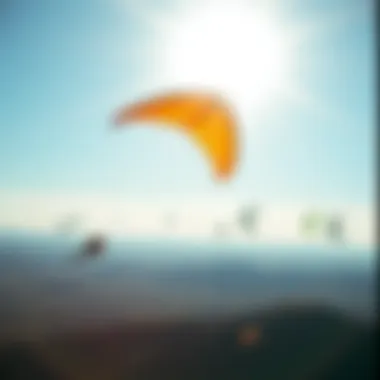
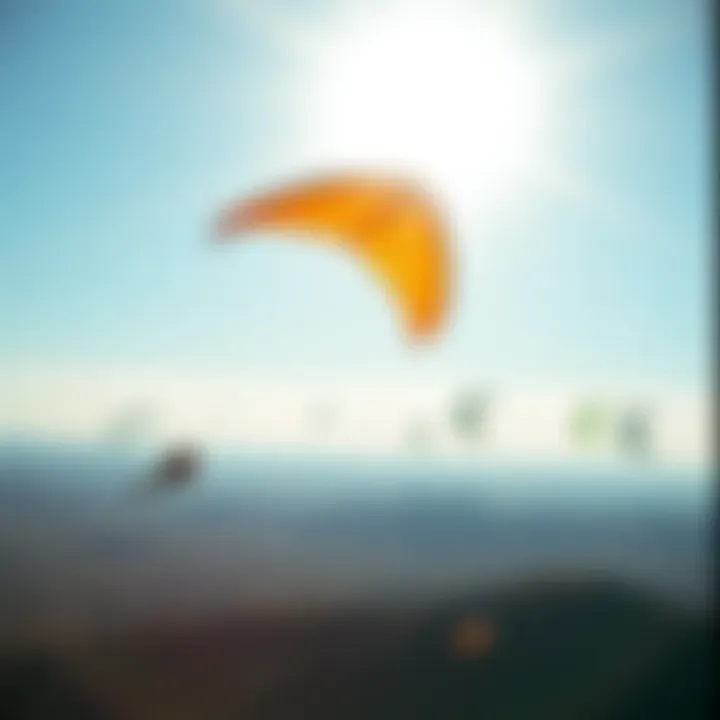
Intro
Kiteboarding, a thrilling wind-powered sport, invites enthusiasts from all walks of life to feel the rush of gliding across the water. Yet, when the winds roar, kiteboarding transforms into a whole different beast. Navigating strong winds demands not only the right gear but also a keen understanding of techniques and safety measures. Whether you are just starting out or have years of experience under your belt, tackling strong winds can enhance your skills and elevate your kiteboarding game.
With a focus on kites engineered specifically for robust conditions, this guide unpacks essential elements that kiteboarders need to consider. From material attributes to size selection, you'll learn how to fine-tune your equipment to match the storm. Additionally, we delve into advanced techniques and tips that will not only keep you safe but will also ensure you make the most of each windy session.
By navigating through this narrative, both beginners and seasoned kiteboarders will gain valuable insights to conquer the winds. Let's strap on your harness and take off into the captivating world of kiteboarding amidst the gales.
Understanding Strong Winds
Understanding strong winds is crucial for kiteboarders who want to harness the power of nature while staying safe. The dynamics of wind play a significant role in the overall kiteboarding experience, shaping everything from the choice of gear to the techniques used on the water. Recognizing how wind behaves in various conditions can make the memorable moments spent on the water even more enjoyable.
Defining Strong Wind Conditions
When we talk about strong wind conditions, it’s essential to pinpoint what that really means. Typically, wind speeds of over 20 knots (which translates to roughly 23 miles per hour) are considered strong for kiteboarding. However, even slight variations, such as gusts reaching up to 30 knots, can dramatically influence the handling of a kite.
Factors that define these conditions include:
- Sustained Wind Speed: This is the measurement of wind over a specific period. Steady, strong winds allow for consistent control, while fluctuating winds lead to an unpredictable ride.
- Gusts: Sudden increases in wind speed can catch even seasoned kiteboarders off guard. A gust can quickly sweep across the water, impacting how a kite behaves and a rider’s ability to manage it.
- Directional Changes: Winds can change directions unexpectedly. This variability can complicate navigation and control.
Understanding these aspects helps kiteboarders prepare better by selecting appropriate equipment and techniques suitable for such environments.
Impact of Wind Variation on Kiteboarding Experience
Wind variation can create a rollercoaster of sensations for kiteboarders, and understanding its nuances is vital. When the wind is consistent and steady, riders can enjoy a smooth ride where they can focus more on tricks and less on double-checking their gear or management.
But when winds fluctuate, the challenge increases. Here’s how different wind variations can affect the experience:
- Faster Speed: Strong, consistent winds enable high speeds, allowing riders to cover more distance in less time. This not only heightens excitement but also increases the potential for aerial maneuvers.
- Potential for Overpowering: In gusty winds, kites can easily feel overpowering. It demands a careful balancing act to keep the kite stable, enhancing the risk of crashes, particularly for those who are still finding their legs.
- Skill-Level Significance: Less experienced riders might find variable winds intimidating. Strong winds can expose weaknesses in technique, while seasoned kiteboarders might relish the challenge and even refine their skills with more demanding conditions.
Ultimately, acknowledging the impact of wind variation can help kiteboarders tailor their approach, adjusting their mindset and techniques for more enjoyable and effective sessions on the water.
"Kiteboarding is about feeling the wind and water as one. Strong winds can either elevate your experience or challenge you to overcome obstacles."
For those interested in delving deeper into this subject, resources like Wikipedia on Wind or community discussions on Reddit can provide broader insights into understanding wind conditions in kiteboarding.
By grasping these core concepts, kiteboarders can better prepare themselves, ensuring both safety and enjoyment as they navigate the waves.
Kite Characteristics for High Winds
Kites designed for strong winds possess unique characteristics that set them apart from standard models. Understanding these traits is critical for kiteboarders seeking to harness powerful gusts effectively. Strong winds can turn a mediocre ride into a thrilling experience, but this is contingent upon the right equipment. The importance of kite characteristics for high winds boils down to safety, performance, and enjoyment. Choosing the appropriate kite can mean the difference between a exhilarating day on the water or a harrowing experience that might lead to accidents.
Shape and Design Considerations
When it comes to strong wind conditions, the shape and design of the kite play a pivotal role. Kites that are flatter and have a broader wingspan tend to perform better in high winds. The reason for this is quite simple: flatter kites catch less wind and maintain stability, making them easier to control.
- Delta Wings: Kites shaped like a triangle tend to hold up well against strong gusts. The design naturally directs the wind flow over the surface, providing balanced lift and control.
- C-Kites: Known for their distinctive C shape, these kites are favored by many advanced riders for their responsiveness and power. Their design harnesses strong winds efficiently, giving you enough boost to jump higher.
- SLE Kites: Support Leading Edge kites, often equipped with extra support struts, offer added stability. They’re particularly good in unpredictable wind patterns, providing riders with more confidence.
Ultimately, the goal is to ensure your kite stays steady in the air, preventing unwanted spins or tumbles that could lead to accidents. The design must not only prioritize aerodynamic efficiency but also address safety features to keep riders protected in rougher conditions.
Material Strength and Durability
Another crucial factor is the material used in constructing the kite. Strong winds can wreak havoc on fabric, leading to tears and even complete failures if the right materials aren't employed. Most quality kites for high winds are made from robust nylon or polyester, designed to withstand stress.
- Ripstop Fabric: This material features a grid structure that reinforces the strength of the kite, preventing small tears from growing larger. Kites made of ripstop fabric offer both durability and lightweight performance.
- Double-Stitching: A kite's seams are often one of the most vulnerable areas. Strong wind kites typically use double-stitch techniques that bolster seam strength, minimizing the chances of breakdown under rigorous conditions.
- UV Resistance: Extended exposure to sunlight can deteriorate the material. Kites engineered for strong winds often include UV-resistant properties, extending their lifespan.
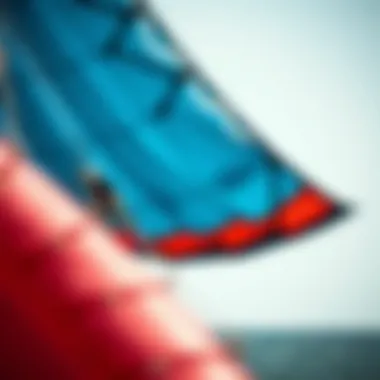
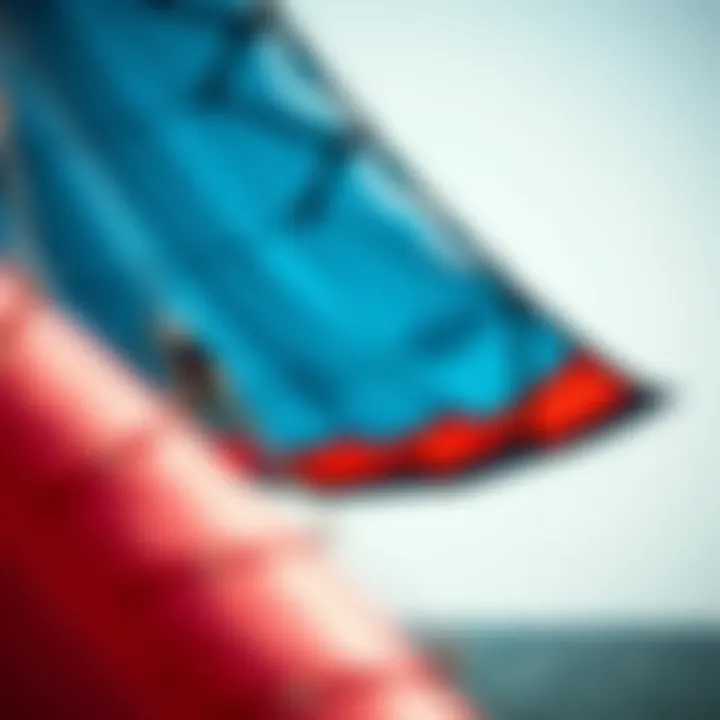
"The right material can be your best ally against the elements; skimping here can lead to regret later."
Maintaining kites with strong materials ensures they not only survive the elements but also perform optimally, giving riders the confidence they need in harsh conditions. By focusing on shape, design, and material strength, kiteboarders can better prepare themselves for the exhilarating challenge of strong winds.
Selecting the Right Size Kite
Choosing the right size kite is not just a matter of personal preference; it significantly influences your performance and safety while flying in strong winds. A kite that suits the conditions and your individual characteristics can make the difference between enjoying an exhilarating ride or facing an uphill struggle. Understanding kite sizes is crucial to not only optimize your experience but also to stay safe, especially when the winds pick up. The right size kite not only enhances your control but also minimizes risks associated with adverse wind conditions.
Understanding Size Ratings
Kite sizes are typically measured in square meters, indicating the total area of the kite’s surface. Different brands employ various systems for size ratings, which can add another layer of complexity. For instance, a 9m kite might feel substantially different from a 9m kite from another manufacturer due to variations in design and construction.
It’s essential to know how your chosen kite size interacts with wind speed. Here are some essential pointers regarding size ratings:
- Small Kites (6m to 8m): Ideal for strong winds. They allow for quick and responsive turns but provide less lift. A small kite can help maintain control when the wind is boisterous.
- Medium Kites (9m to 11m): This size is a versatile option for moderate winds. They provide a balance between speed and power, making them suitable for a wider range of conditions.
- Large Kites (12m and above): Generally better suited for lighter winds, as larger kites can become difficult to maneuver in high winds, often leading to instability.
Keep in mind: Choosing a kite that’s too large for the wind conditions can result in reduction in control, while a kite that’s too small might leave you underpowered, leading to a frustrating experience.
Personal Weight Considerations
Your weight plays a critical role in determining the right kite size. Heavier riders will likely benefit from larger kites in the same wind conditions, while lighter riders might find smaller models more effective. An understanding of how weight affects performance can lead to improved kite handling.
To give you a clearer picture of this consideration:
- Light Riders (up to 75 kg): Should generally opt for smaller kites, especially in strong winds. A 7m or 8m kite works well for these individuals.
- Mid-Weight Riders (75 kg to 90 kg): Can consider a medium kite size (8m to 10m), allowing for flexibility in performance as wind conditions vary.
- Heavy Riders (over 90 kg): Often require larger kites, especially in strong winds, usually around 10m or even more, depending on the specific conditions.
Utilizing weight considerations can make your kiteboarding experience more enjoyable, as it aligns your kite choice with your physical profile. Ensuring the right kite size tailored to your weight can unlock a newfound confidence that enhances your overall engagement with the sport.
Keeping in mind both size ratings and your personal weight is essential for a secure and enjoyable kiteboarding experience. The right choice can make you feel like the wind is at your back, supporting your every move.
By understanding how these elements are intertwined, you can maximize your time on the water, paving the way toward a thrilling kiteboarding adventure.
Popular Kite Models for Strong Winds
When it comes to kiteboarding in strong winds, having the right kite model can make or break the experience. There’s no one-size-fits-all solution here. Specific models can handle the gusty challenges better, ensuring not just safety but also performance and enjoyment. It’s vital for enthusiasts to understand the characteristics of different kites and how they respond to high wind conditions.
High-wind kites are generally stiffer and have a more robust construction than their standard counterparts. They are designed to maintain stability and provide improved control when the wind picks up. With a plethora of options on the market, knowing what sets certain models apart is invaluable.
Brand Comparisons and Performance Reviews
Different brands tout their unique technologies and features, and that can create some confusion. However, a concise comparison can help us see which kites truly rise above the rest in strong winds.
- Naish: Known for their versatility, Naish kites, like the Naish Pivot, offer a great balance between responsive handling and power delivery. They provide excellent upwind performance even in fierce gusts.
- Slingshot: The RPM model from Slingshot is another favorite. It’s known for its exceptional stability and low-end power, a lifesaver when winds strengthen suddenly. Users often cite its easy relaunch as a significant advantage in adverse conditions.
- F-One: With models like the Bandit, F-One has established a reputation for crafting high-wind kites that excel in performance. Their designs cater to riders looking for speed and agility in challenging environments, offering both performance and control.
Each brand has its pros and cons; hence, understanding your riding style and preferences is key. Performance reviews online, such as those found on www.reddit.com or specialized kitesurfing forums, can provide personal insights that are often more relatable than manufacturer specs.
User Recommendations and Feedback
There’s nothing quite like the testimonials from riders who’ve put these kites through their paces. Harnessing real-world feedback can guide prospective buyers.
- User Experiences: Many kiteboarders praise the North Kiteboarding’s Orbit for its impressive wind range. Users often mention how it performs well even at the extremes of its wind capabilities, making it a reliable choice on blustery days.
- Social Media Insights: Platforms like www.facebook.com can shed light on community opinions. Groups dedicated to kiteboarding often have threads where riders share their favorites, discuss durability, and performance in rough scenarios.
- Expert Reviews: Websites like britannica.com provide an in-depth analysis of many brands; however, someone who has ridden a particular kite will have that touch of real experience that can’t be matched.
Gathering a mix of these insights can give a well-rounded view of what to expect from popular models for strong winds, ensuring kiteboarding enthusiasts make informed choices.
Techniques for Managing Kites in Strong Winds
When it comes to kiteboarding in challenging weather, the mastery of kite management is a game changer. Understanding how to control your kite effectively in strong winds can make for a safer and more enjoyable experience. Improper handling can turn an exhilarating ride into a precarious situation, so having a solid grasp of the techniques involved is essential for both newbies and seasoned riders alike.
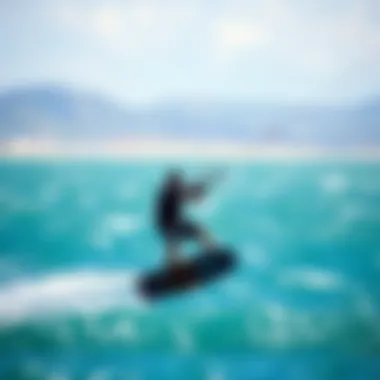
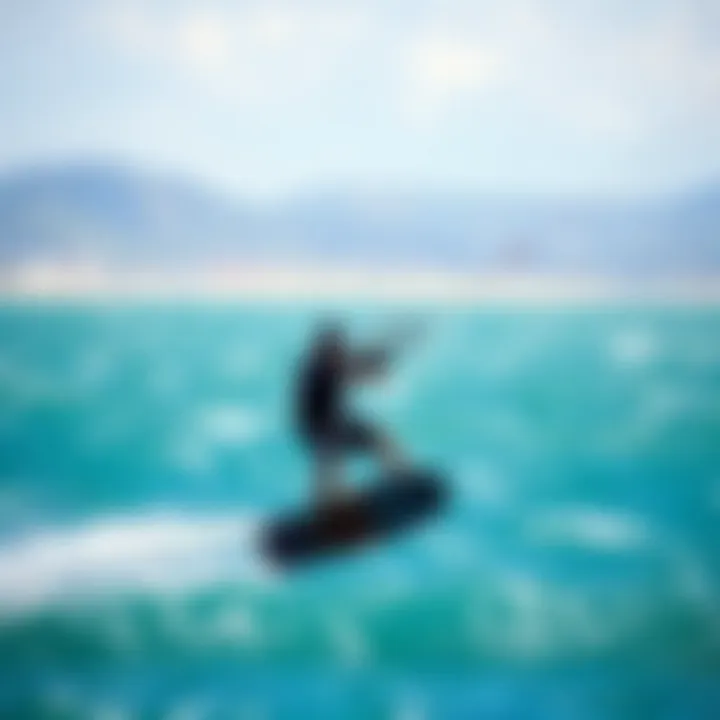
Controlling Speed and Direction
One of the primary concerns when kiteboarding in robust winds is managing your speed and direction. The wind's intensity can drive your kite faster than one might expect, often leading to unintentional crashes or loss of control. Here’s how you can maintain command over your kite:
- Use the Depower Line: The depower line is a lifeline in gusty conditions. Pulling this line can significantly reduce power, allowing you to regain control over speed and direction. It acts as a safety net, especially when you feel the kite pulling too hard.
- Adjust the Angle of Attack: By altering the angle at which your kite faces the wind, you can control lift and drag. A kite a bit further back in the wind window reduces power, while positioning it forward increases speed and lift. Practicing this control can change the flow of your performance.
- Watch the Wind Window: The wind window is the space where your kite flies effectively, and being aware of it is crucial. Keep your kite at the edge of this window to gain more control over direction while minimizing power. It’s all about finding that sweet spot where you can slice through winds comfortably and steer with finesse.
Regular practice in varying conditions will help you hone these skills; it’s not just about theory but also about feeling how the kite responds in those windy gusts. Moreover, communication with fellow kiteboarders helps to understand local conditions and can guide you in adjusting your techniques when needed.
Learning How to Depower Effectively
Depowering your kite is a technique that all kiteboarders should master, especially when the wind picks up. Here’s how you can nail this skill:
- Recognizing When to Depower: The ability to sense when winds change is vital. If you find the kite pulling excessively, it’s a clear sign that you must depower. Keep an eye on the wind conditions, and don’t hesitate to adjust.
- Gripping the Control Bar: Most kites are equipped with a control bar that allows you to pull or push. Pushing the bar away from you can depower the kite while pulling it in allows you to gain some speed. Familiarizing yourself with your kite’s specific control mechanisms will enhance your reaction times.
- Practice One-Handed Control: Sometimes, you may need to use one hand to manage your kite while maneuvering through obstacles or while landing. Getting comfortable with one-handed control can make a world of difference in tough situations.
"Mastering depowering techniques can mean the difference between a thrilling ride and a losing battle against the wind. Practicing these skills in a controlled environment can boost your confidence for unpredictable conditions."
Lastly, never underestimate the value of thorough preparation. Knowing your surroundings and the expected wind patterns can guide how and when to apply these techniques.
Incorporating these practices into your routine can dramatically change your kiteboarding experience, especially in stronger winds. They'll lead you to navigate the wind like a pro, providing you with more enjoyment and less anxiety out on the water.
Safety Precautions for Higher Wind Conditions
When it comes to kiteboarding in strong winds, prioritizing safety cannot be overstated. Many enthusiasts fall into the trap of underestimating the power of nature, thinking they can handle more than they realistically can. By being prepared, not only do you protect yourself, but you also ensure a more enjoyable and less stressful experience on the water.
Kiteboarding in high winds presents unique challenges. The sheer force of wind can turn even the most attractive spot into a chaotic scene. Thus, taking precautions becomes essential to manage risks effectively. This section dives into the two crucial aspects that can make or break your safety while kiteboarding: the gear you wear and your understanding of wind patterns.
Essential Safety Gear
Having the right safety gear is indispensable when kiteboarding in strong winds. This equipment helps mitigate risks and enhances overall safety. Some of the essentials include:
- Wetsuit: A good wetsuit not only keeps you warm but also provides protection against potential abrasions, especially when crashing or getting dragged by the kite. Opt for a thicker one if you expect to face cold waters.
- Impact Vest: This is designed to absorb shocks during unexpected falls or collisions. Some vests also have buoyancy features, adding an extra layer of safety.
- Helmet: Protecting your head is non-negotiable. Given the unpredictable nature of strong winds, a helmet can safeguard you against potential impact injuries.
- Safety Release System: Your harness should come equipped with a reliable safety release mechanism. Familiarize yourself with its operation to enable an expedited response in emergencies.
- Bodysurfing Leash: While falling into the water may be part of the game, a good leach ensures your board doesn’t drift away from you—this is particularly significant in tumultuous conditions.
- First Aid Kit: Bring along a compact first aid kit containing essentials such as band-aids, antiseptic wipes, and adhesive wraps. Minor injuries can deter a great day out.
Being strapped in with the right equipment doesn't just amplify your safety; it also provides peace of mind, letting you focus on your kiteboarding skills rather than potential dangers.
Understanding Wind Patterns and Local Conditions
Knowledge of wind patterns is like having a map to navigate through a challenging wilderness. It’s what sets apart a successful adventure from a disastrous one. Each location has its own set of conditions, influenced by geography, weather patterns, and local climate.
- Local Reports: Before heading out, check local wind conditions and forecasts. Websites or apps that specialize in kiteboarding reports can be beneficial, as they often provide hourly updates on wind speeds and direction. Some valuable resources include NOAA or specialized kiteboarding communities on Reddit.
- Wind Geometry: Familiarize yourself with how the wind interacts with natural elements like trees, hills, or buildings. These can create pockets of turbulence or unexpected gusts, making certain areas riskier than others.
- Wind Direction: Knowing the direction of the wind is equally important. Inconsistent or shifting winds can lead to serious problems. For instance, side-on winds are often ideal, while off-shore winds can pose a higher danger.
- Observing Others: Take a moment to watch more experienced riders. Studying their maneuvers and how they adjust to the wind can provide valuable insights for your own approach.
"The wind is always a factor; being able to read it can be the difference between a thrilling ride and a dangerous ordeal."
Understanding local wind conditions and patterns helps you gauge when it's too windy to ride. Ignoring these elements can lead to injuries or accidents. Therefore, always stay informed and adapt accordingly. Knowledge is not just powerful; it's life-saving in the world of kiteboarding.
Maintaining the right attitude towards safety will ultimately transform your kiteboarding journey into a fulfilling experience rather than a perilous one. Equip yourself with the necessary safety gear, learn to read the wind, and always keep an ear to the ground with regards to local conditions. With these precautions in mind, you can enjoy the excitement of kiteboarding in strong winds with minimal risk.
Maintenance of Kites for Strong Winds
Proper maintenance of kites is essential to ensure their longevity, particularly when you're consistently using them in strong wind conditions. Kites endure immense stress, and a minor oversight can lead to mishaps on the water. By dedicating time for regular maintenance, you can enjoy many successful rides without the nagging worry of equipment failure.
Keeping kites in prime condition does not just enhance performance but also ensures safety while kiteboarding. A well-maintained kite responds more predictably to control inputs. The peace of mind gained from knowing your gear is in optimal shape allows you to push your skills further and take on challenging wind conditions with confidence.
Regular Inspection and Repair
The foundation of keeping kites in shape lies in regular inspections. Prior to each session, it is wise to inspect the fabric, lines, and connections thoroughly. Look for:
- Tears or abrasions in the fabric
- Frayed lines or any signs of wear
- Damaged connectors or quick release systems
- Inflation issues in the bladder (if required)
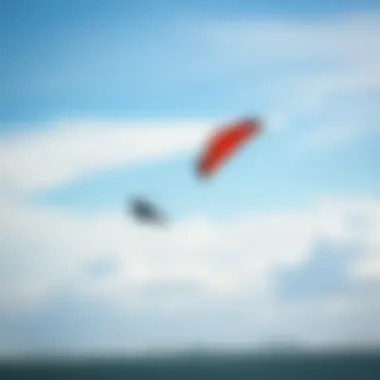
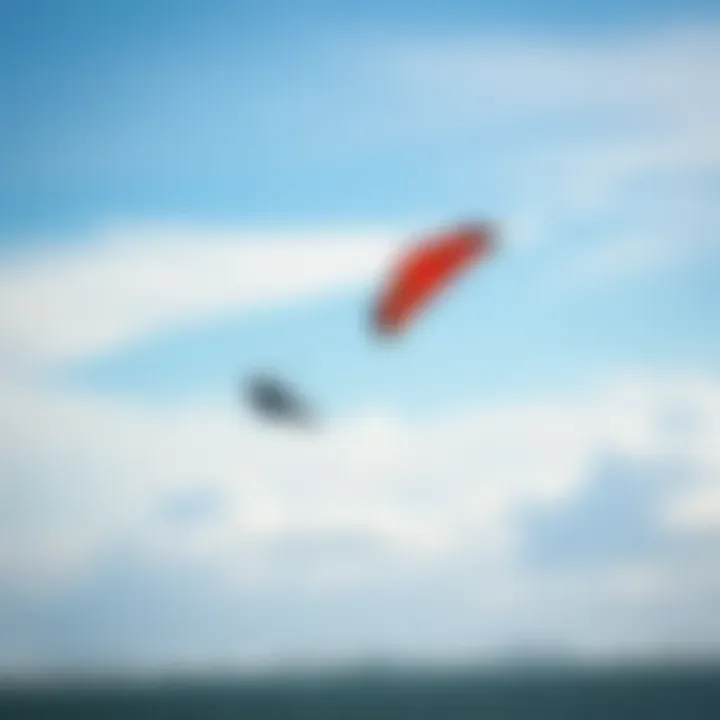
If any issues arise, it’s crucial to address them immediately. Patching small holes can be done easily with repair tape, and replacing frayed lines can prevent snap events mid-flight, which can lead to a loss of control. Your gear is an extension of your ability; keeping it in top condition is a reflection of serious commitment to the sport. If you are not sure about performing these repairs on your own, there are plenty of professional repair services available to help you out.
Regular maintenance isn’t just a chore; it's a commitment to the sport and your safety.
Storage Recommendations to Extend Lifespan
Storage plays a significant role in extending the lifespan of your kite. After a long day out in the wind, folks often toss their kite into a corner and call it a day. But this practice can lead to damage over time. Consider these storage tips:
- Dry Before Storage: Always ensure your kite is completely dry before putting it away. Damp fabric can lead to mold and weaken the material, turning a perfectly good kite into useless fabric.
- Avoid Direct Sunlight: Prolonged exposure to UV rays can deteriorate the kite's fabric. Store it in a cool, shaded area to maintain integrity.
- Use Protective Bags: Invest in a good quality carrying bag that offers padding. It protects against accidental scrapes and bumps when transporting.
Moreover, check your storage location. An attic or garage can be conducive to extreme temperature fluctuations that could adversely affect the materials. Finding a stable environment will make a world of difference in the longevity of your kites.
By paying attention to maintenance, you not only ensure your gear is in excellent shape but also enhance your kiteboarding experience. Take your time, inspect, repair, and store wisely, and your kites will reward you with countless thrilling adventures.
Community Insights and Discussions
Engaging with the kiteboarding community provdies a wealth of benfits that can enhance a rider's experience and knowledge. These insights are crucial for anyone looking to improve their skills and navigate the often-turbulent world of kiteboarding in strong winds. This sub-section will delve into the importance of connecting with fellow enthusiasts and the valuable information that can be gleaned from such interactions.
Gathering Knowledge from Experienced Riders
The knowledge shared by seasoned kiteboarders is akin to gold in the world of kiteboarding. Experienced riders have logged countless hours in a variety of wind conditions, often facing the same challenges that newer enthusiasts encounter. They offer firsthand accounts of what equipment works best under strong winds and the best practices for controlling kites in those conditions. Here are some key aspects to consider when gathering insights from these seasoned individuals:
- Tips on Gear Selection: Veteran kiteboarders often have a preferred brand or model that they suggest for high winds, based on personal experience and performance assessments.
- Techniques for Handling Challenges: Learning how to manage a kite during gusty winds can be daunting, but hearing stories and techniques from those who've succeeded can illuminate the path for less experienced riders.
- Safety Tips: Those who have faced dangerous situations can share what they did to avoid mishaps or accidents, providing invaluable lessons for others.
Connecting with these riders often happens through various platforms like forums on Reddit or Facebook groups dedicated to kiteboarding. Moreover, face-to-face interactions in local kiteboarding spots can yield equally insightful conversations.
Participating in Local Kiteboarding Events
Joining local kiteboarding events fosters a sense of community while affording an array of benefits. These gatherings are like informal classrooms, where novice kiteboarders can learn from the pros and vice versa. Here’s what you gain from participation:
- Skill Development: Events often include workshops or tutorials, allowing participants to refine their skills under the watchful eye of experienced coaches.
- Networking Opportunities: Meeting fellow enthusiasts can lead to friendships and potential partnerships for future kiteboarding sessions or even competitions.
- Exposure to New Gear: Local events often showcase the latest gear from various brands, allowing enthusiasts to get a firsthand look at new models tailored for strong winds.
- Inspiration and Motivation: Watching skilled athletes tackle strong winds can inspire newer riders, providing motivation to overcome personal barriers and enhance their techniques.
In summary, delving into community insights and engaging in discussions with experienced riders plays an essential role in kiteboarding proficiency, particularly in strong wind conditions. Participating in local events not only builds camaraderie but also serves as a robust platform for knowledge exchange that supports both personal and communal growth.
"Kiteboarding isn’t just a sport, it’s a community where shared experiences transform personal challenges into collective wisdom."
For further insights and discussions, consider visiting Reddit Kiteboarding or joining local meetups that explore various aspects of this enthralling sport.
Culmination: Mastery in Strong Winds
As we wrap up our exploration of kiteboarding specifically designed for robust wind conditions, it’s vital to stress that mastery doesn’t come overnight. This section seeks to underscore the significance of combining practice with well-rounded knowledge. Only by immersing oneself in both theory and hands-on experiences can enthusiasts truly navigate the challenges that strong winds bring.
Emphasizing the Importance of Practice and Knowledge
To be proficient in kiteboarding under turbulent conditions, repetition plays a crucial role. Regular practice increases muscle memory, allowing the kiteboarder to instinctively react to sudden shifts in wind strength or direction. Moreover, familiarity with the equipment—how it moves and responds in high winds—can make all the difference. Training sessions should be focused and include challenges that replicate high-wind scenarios. For instance, practice might involve using various kite sizes or tweaking your techniques based on wind variations.
Additionally, educational resources are essential. Understanding wind patterns, topographical influences, and kite dynamics provides kiteboarders with a sharper insight into outdoor environments. Books, online courses, and discussions with seasoned riders can broaden perspectives, making it easier to make informed choices on the water. This synthesis of knowledge reinforces confidence, transforming encounters with strong winds from intimidating experiences into exhilarating adventures.
Looking Ahead: Innovations in Kite Technology
The world of kiteboarding is ever-evolving, and as kite engineers push the envelope with innovative materials and designs, we stand on the cusp of significant advances that are exciting and pivotal for enthusiasts. Take for instance developments in lightweight fabrics that not only enhance durability but also optimize lift in gusty conditions. As resistance becomes lower while responsiveness rises, riders can expect to enjoy a smoother, more controlled experience.
Another noteworthy trend is the rise of smart kites that utilize sensors to analyze wind conditions in real time. These kites can adjust their angle or shape, thereby providing an adaptive flying experience that caters to varying influences instantly. Such innovations could mean the difference between a stellar ride and a precarious struggle in strong winds.
It’s also important to watch for advancements in safety gear and techniques, which continue to develop alongside kite technology. New materials in harnesses and personal flotation devices are becoming lighter and less cumbersome, affording better mobility without compromising safety.
"The future looks promising for kiteboarders willing to embrace change. With a blend of solid practice and embracing modern technology, the thrill of kiteboarding in strong winds will continue to allure."
To sum up, the journey to mastering kiteboarding in strong winds combines a commitment to practice with an eagerness to learn about the latest in technology and equipment. By staying informed and adaptable, kiteboarders can empower themselves to tackle the elements, turning difficulty into delight.
For more information and discussions about kiteboarding, you might find these resources useful:















